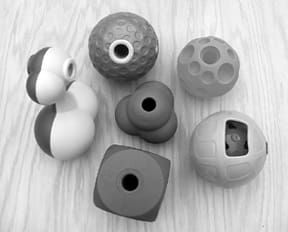Interactive toys that require your dog to do something to make the toy pay out food treats are a great invention. They can assist with behavior modification programs and help to keep your dog busy, out of trouble, and well-behaved in your home. The more time your dog spends pursuing one, the more energy she expends in your absence, the more tired she is by the time you get home. And a tired dog is a well-behaved dog.
First on the interactive scene was the Buster Cube, followed by the Roll-A-Treat Ball, now joined by a whole host of other interactive products. We decided it was high time to compare some of these treat-dispensing toys to see which ones can give you and your dog the most value.
We evaluated several features in our test products: sturdiness, rate of treat payout, ease of treat-loading, steepness of the learning curve for our test dogs, value as an interactive toy, safety, noise factor, and cost. We also looked for the following traits:
• sturdy enough to withstand the assault of frustrated canines’ canines when the well of treats runs dry
• no parts that can be easily removed and swallowed; no holes big enough to trap doggie jaws
• ability to keep dogs active and interested for long periods
• offer a high enough payout rate to hold the dog’s interest but not so high that the treats run out in five minutes
• quiet enough that they don’t drive you (or your next-door-apartment-dwelling neighbor) crazy
• easy to load with treats
• simple enough for the dog to learn how to use them in a reasonable period of time
• and, of course, affordable.
All of the top-rated products are hard to clean, by the way. When they need cleaning, we suggest sending them through the dishwasher, then doing your best so shake out excess water and setting them out to finish drying before loading them up with treats again.
Teaching Fido to treat himself
Dogs who have not been exposed to treat-payout toys will probably need to be shown what to do. This is simple. Just load your treats into the toy, show it to your dog, and tip it so a treat falls out. Encourage her to sniff and paw at the toy. If your dog has been taught to target, you can use the “touch” cue to get her to push at the ball with her nose. (See “Right on Target,” WDJ March 2001.) It may be necessary to tip out a few more treats until she gets the idea. An occasional dog never gets the idea, but most will catch on sooner or later.
Once your dog has learned the technique, you can use these products to keep her occupied and to use up excess energy by making her work for her meals while you are away all day working for yours. The toys can even help with separation anxiety, by getting the anxious dog to focus on something other than your imminent departure. Instead of plopping her breakfast in her bowl, load her kibble or other morsels of food into the ball and give it to her shortly before you leave. While she is engrossed in pursuing her breakfast, quietly pick up your car keys and escape.
Caution: This obviously does not work for dogs who are crated during your absence, or for dogs who will have to defecate if they eat their meal while you are gone. It is also not appropriate for multiple-dog packs whose members include one or more dedicated food-guarders; in order to avoid dogfights, these dogs should be separated if you are going to leave them with treat-payout products.
Also, remember that safety and sturdiness are relative – one dog’s lifetime play object may be another dog’s five-minute hors d’oeurve. Be sure to judge the safety of these products for yourself, based on your own dog’s history and behavior.
Top dog toys
We started with the Buster Cube, since it’s been on the market the longest and has lots to like. It is made of a sturdy hard plastic and the payout cylinder is adjustable, so once your dog learns how to use it at maximum payout level, you can set it to minimum and make the fun last longer for her.
It is moderately easy to load, and we love that the company recently came out with the Mini model, since the original cube was definitely a challenge for small dogs to maneuver.
There are a few things we don’t like about it, but they aren’t significant enough to take away a 4-paw rating. The Buster Cube’s learning curve can be too steep for some dogs. While our assertive Scottish Terrier tester had no trouble working the cube, some of our “softer” dogs never did get the hang of it. It was also difficult to move the loading cylinder from maximum to minimum – we had to use a screwdriver to accomplish this.
The Buster Cube is more time-consuming to load than some of the other products. Made of hard plastic, it can make a lot of noise. And, while the price range for treat payout products is narrow (from $3 to $20), this one is at the higher end of the range at $12 – $15.
We were pleasantly surprised by the Molecuball. Very simple, with no moving parts or adjustable payout, it is made of hard rubber-like plastic in a “molecule” shape that tends to cause dog teeth to slip off rather than destroy. The softer plastic also makes it a much quieter play toy, which can be a sanity and neighbor-relations saver. It rolls more easily than the Buster Cube, so might be a better choice for softer dogs. Our Scottie adored it, and continued to play with it long after the treats were gone, and most of our less forceful test dogs were able to make it work as well. It’s very affordable, easy to load, and dishwater drains out easily.
It’s not perfect, however. The rubber-like plastic is nowhere near as indestructible as a Kong; an aggressive chewer could probably succeed in destroying the Molecuball fairly easily.
The Roll-A-Treat Ball is our favorite choice for soft dogs who can’t or won’t push hard enough to make the Buster Cube or Molecuball work. It rolls at the touch of a feather, and our Scottie had a wonderful time playing high-speed soccer with it. Our softer dogs also had no problems learning how to make it work, although they preferred following the Kelpie, happily picking up the treats that she ignored, as she was more obsessed with making the ball roll than eating treats. The payout cylinder is easily adjustable from minimum to maximum, and the ball is very easy to load – just remove the cylinder and pour in the treats, reinsert the cylinder. We love the price and the choices of sizes and colors.
The Roll-A-Treat ball does have some flaws. It makes an ungodly racket, especially on cement or hardwood floors, and can do some damage smashing into furniture when it gets up to speed. Carpet slows it down, but the noise can be very annoying, and repeated impact can cause significant wear and tear on your household.
Even more serious, the payout cylinder is way too easy to remove. A dog intent on mayhem could probably gnaw it out in short order, munch it, and risk intestinal damage from sharp plastic pieces. We would recommend this ball for dogs who are not determined chewers, and suggest that you supervise the activity at first to be sure they don’t dismantle the innards.
The Wobble Bone is entertaining, and a relatively safe hard plastic, but it’s a stretch to call it a true interactive toy. The treat reservoir is small, located in the small end of the bone, and the dog tips the toy over to make the treats fall out. The weighted bottom then makes the toy stand back up. Our Scottie figured it out in no time, and also delighted in picking it up by the slender “waist” and carrying it around. Some of our softer test dogs also got the hang of it easily, but our two older dogs never did manage to figure it out.
The Wobble Bone loads easily, but its real shortcoming is that the treat reservoir is so small and the treats fall out so easily that it takes only a couple of minutes to empty it. That leaves at least seven hours and 55 minutes of an eight-hour day for your bored dog to get into mischief.
The Talk To Me Treat Ball is actually a combination of two different types of toys. It does dispense treats, but it also has a small, battery-operated, motion-activated, recording and playback unit snugly screwed into one end.
You can remove the unit, record your own voice, screw it back in, and when your dog pushes the ball around he hears your voice. It’s a cute gimmick.
As a treat ball, it’s a decent product. Although the payout isn’t adjustable, it’s easy to load and the treats fall out at a reasonable rate. There’s no cylinder to come loose as with the Roll-A-Treat Ball, and the recording unit fits tightly enough to not be a concern, except perhaps, for the most aggressive of chewers. It is, however, made of that noisy hard plastic, and another good candidate for annoying the neighbors.
While an interesting novelty, the recording aspect is not likely to do much to resolve your dog’s separation anxiety or loneliness as advertised. The recording quality is poor – your dog may not even recognize it as your voice – and our test dogs paid little or no attention to it. Plus, that novel feature jacks the price to the top of this list of toys.
Overall, it’s a fun gadget to give to a fellow dog-lover as a gift, a decent but expensive interactive treat ball, and a better choice than the Roll-A-Treat Ball for aggressive chewers.
The highway-orange product called Tricky Treats confounded us. Although the package calls it “indestructible,” it is made of a rubbery plastic with concave craters of various sizes that showed significant damage from our Scottie’s unforgiving jaws after just moments of attention. Worse than that, the treats simply don’t fall out.
The design is extremely poor – when the treat opening is toward the floor, all the treats collect at the bottom, blocked by the interior lip, and can’t get to the hole to fall out. Our intrepid Scottie couldn’t get a single treat to come out, which frustrated him and made him chew harder on the soft plastic. Even vigorous human shaking was only mildly successful at releasing treats from the ball prison. If you want a bright orange fetch-ball with craters, go for it. If you want an interactive treat ball, look elsewhere.
In our opinion, the Crazy Ball has few redeeming qualities. It’s a hard plastic ball within a hard plastic ball, which compounds its noise potential.
The treats are loaded with some difficulty into the interior ball through bone-shaped slots (to match the shape of Nylabone’s so-called “Healthy Edibles Bacon Mini-Chew” treats, included with the ball). Loaded with artificial colors, the treats are definitely not WDJ-approved. Also, you can’t adjust the rate of payout.
You could, of course, use your own treats. Still, this doesn’t alleviate our concern about this toy’s worst flaw: A dog could get her jaw or paw stuck between the two balls. We suggest you avoid this product.
-by Pat Miller







What you recommend to grinding a dog nails.